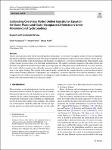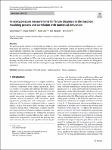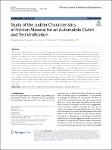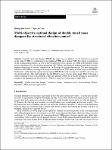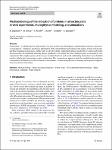Search
Author
- Amir, Ebrahimi (2)
- Aydin, Azizi (2)
- George, Haller (2)
- James, M. Fiore (2)
- next >
Subject
- robotics (9)
- Engineering (8)
- engineering (8)
- công nghệ (3)
- next >
Date issued
- 2020 - 2023 (215)
- 2010 - 2019 (28)
- 2001 - 2009 (6)
Has File(s)
- true (249)
Search Results
Various elasto-plastic models for the rate-independent deformation, various elasto-viscoplastic models for the rate-dependent deformation and their combinations have been proposed during a long time more than one or more centuries. Firstly, the history of the development of the elastoplasticiy and the elasto-viscoplasticity is reviewed comprehensively. Unfortunately, each of these models possesses their own drawbacks and limitations. The unified constitutive equation of the elasto-plastic and the elasto-viscoplastic deformations is provided by incorporating the subloading surface model into the overstress model in this article, which is capable of describing the monotonic and the cyclic loadings at the general rate ranging from the quasi-static to the impact loading. |
Moving-object tracking using a pan–tilt camera setup is quite a well-known task in robotics. However, the presented research addresses specific properties of the tracked object and introduces novel features to the pan–tilt camera control strategy. Pan–tilt camera control does not operate in an isolated environment. It is a part of the visual servoing system with specific goals. The system has to fulfill certain purposes, which affect its configuration and functionality. The pan–tilt system aims at keeping the visually tracked object within the middle of the image. At the same time, the overall visual servoing efficiently recognizes and tracks the object enabling its grasping by the robot arm. It uses a predictive strategy utilizing specific second-order linear models for pan and til... |
The water-lubricated thrust bearings of the marine rim-driven thruster (RDT) are usually composed of polymer composites, which are prone to serious wear under harsh working conditions. Ultrasonic is an excellent non-destructive monitoring technology, but polymer materials are characterized by viscoelasticity, heterogeneity, and large acoustic attenuation, making it challenging to extract ultrasonic echo signals. Therefore, this paper proposes a wear monitoring method based on the amplitude spectrum of the ultrasonic reflection coefficient. The effects of bearing parameters, objective function, and algorithm parameters on the identification results are simulated and analyzed. Taking the correlation coefficient and root mean square error as the matching parameters, the thickness, soun... |
The technology of functionally graded concrete (FGC) is a new methodology in the field of concrete construction, striving for mass savings by adjusting the elements interior design. A promising approach herein is meso-gradation, where concrete hollow spheres are placed inside the formwork before casting the element; this allows up to 50% mass savings without a loss in load-bearing capacity, whilst also ensuring recyclability compared to e.g. bubble decks. In order to prevent damage/displacement of the spheres during automated fabrication, the extruded concrete flow must avoid the spheres, whilst neatly covering the elements area in order to prevent cavities. Both requirements formulate a complex path planning problem that must be solved in order to achieve automated fabrication. In ... |
Brain-computer interfaces (BCIs) are emerging as a promising tool for upper limb recovery after stroke, and motor tasks are an essential part of BCIs for patient training and control of rehabilitative/assistive BCIs. However, the correlation between brain activation with different levels of motor impairment and motor tasks in BCIs is still not so clear. Thus, we aim to compare the brain activation of different levels of motor impairment in performing the hand grasping and opening tasks in BCIs. |
The pressure profile analysis for monitoring and diagnosis processing failures during an injection moulding process, such as burn marks and short shots, is a useful instrument for process and part quality control and production with zero defects and greater efficiency. Therefore, this work aims to demonstrate the in-cavity pressure monitoring feasibility for failure diagnosis and injection moulding process optimization. The methodology used to analyse the obtained pressure variation is presented. The results were correlated to the typical cavity pressure profile, which enables the acquisition of information about the process and the moulding tool. This way, it was possible to determine the origin of the defects present in the injected parts, focusing not only on the velocity to pres... |
The friction judder characteristics during clutch engagement have a significant influence on the NVH of a driveline. In this research, the judder characteristics of automobile clutch friction materials and experimental verification are studied. First, considering the stick-slip phenomenon in the clutch engagement process, a detailed 9-degrees-of-freedom (DOF) model including the body, each cylinder of the engine, clutch and friction lining, torsional damper, transmission and other driveline parts is established, and the calculation formula of friction torque in the clutch engagement process is determined. Second, the influence of the friction gradient characteristics on the amplification or attenuation of the automobile friction judder is analyzed, and the corresponding stability an... |
A double tuned mass damper (DTMD) for suppressing oscillations of civil structures is proposed in this study. DTMD is a combination of an undamped TMD and a smaller TMD. The impact of parameters on the essential characteristics, as well as the vibration absorption capacity of DTMD, is investigated. Using genetic algorithms (GA), the optimum parameters of DTMD are determined by minimizing the peak dynamic magnification factor of structural responses for a wide range of excitation frequencies. The effectiveness and robustness of DTMD are also compared with those of the optimized TMD having a similar weight as the DTMD. Furthermore, multi-objective optimization designs of DTMD (for both two-objective and three-objective) are also developed here. This study indicates that the DTMD is mo... |
Cell motility—a cellular behavior of paramount relevance in embryonic development, immunological response, metastasis, or angiogenesis—demands a mechanical deformation of the cell membrane and influences the surface motion of molecules and their biochemical interactions. In this work, we develop a fully coupled multi-physics model able to capture and predict the protein flow on endothelial advecting plasma membranes. The model has been validated against co-designed in vitro experiments. The complete picture of the receptor dynamics has been understood, and limiting factors have been identified together with the laws that regulate receptor polarization. This computational approach might be insightful in the prediction of endothelial cell behavior in different tumoral environments, ci... |
Modern manufacturing has to cope with dynamic and changing circumstances. Market fluctuations, the effects caused by unpredictable material shortages, highly variable product demand, and worker availability all require system robustness, flexibility, and resilience. To adapt to these new requirements, manufacturers should consider investigating, investing in, and implementing system autonomy. Autonomy is being adopted in multiple industrial contexts, but divergences arise when formalizing the concept of autonomous systems. To develop an implementation of autonomous manufacturing systems, it is essential to specify what autonomy means, how autonomous manufacturing systems are different from other autonomous systems, and how autonomous manufacturing systems are identified and achieved... |

